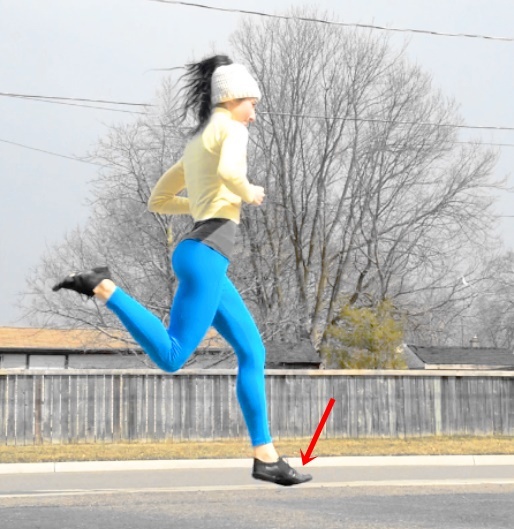If your legs hurt while running, you can run with better impact-protection by running with a forefoot strike, rather than a heel strike landing pattern of the foot.
It turns out that the essential features of a forefoot strike, such as ankle plantarflexion (front of the foot points down, shown below) upon and at touchdown, was found to prevent dangerous rises in intramuscular pressure and mechanical loads on the lower leg.

Too much high levels of lower leg intramuscular pressure is a major risk factor for a painful lower leg condition known as chronic exertional compartment syndrome which is all too common among runners, especially heel strike runners!
The research is full countless links between heel strike running and chronic exertional compartment syndrome. Numerous studies have reported increased risk of chronic exertional compartment syndrome in heel strike runners because in heel strike running, the ankle is dorsiflexed (opposite to plantarflexion) at touchdown which was found to exert a large mechanical load on the lower legs because the lower leg muscles are hyper-engaged to constantly pull the forefoot back before and at each step in order for the foot to heel strike (as shown below).

In heel strike running, at heel strike, ankle dorsiflexion (shown above) enables the foot to make initial ground-contact directly on the heel causing the tibialis anterior (shin muscles) to rapidly decelerate plantarflexion which was found to elevate lower leg compartment pressures beyond a tolerable limit (Diebal et al., 2012). Furthermore, lifting the forefoot back at touchdown (ankle dorsiflexion) promoted greater activation of the dorsiflexors which also led to greater anterior compartment pressures during heel strike running (Diver et al., 2005). In all, as the heel strike runner continues to hyper-engage the shin muscles and dorsiflexors in this way with increased running distance and/or intensity, the toll on the lower leg can mount to marked increases in intramuscular pressure to pain-inducing levels which may result in chronic exertional compartment syndrome.
In contrast, forefoot running may safeguard the legs as ankle dorsiflexion is naturally controlled, allowing a plantarflexed position of the foot/ankle complex at touchdown, helping to cancel out heavy loads on the shins and dorsiflexors as well as surface forces. This is why runners who suffer chronic exertional compartment syndrome are very likely to benefit from adopting a forefoot strike running style.

And, since ankle plantarflexion is used at touchdown in forefoot strike running, excessive dorsiflexor muscle activation is spared which may help leverage better energy economy as reduced muscle activity and reduced energy consumption go hand-in-hand!
Even better, Diebal et al., 2011, found that heel strike runners who suffered chronic lower leg compartment syndrome avoided surgical intervention just by switching to forefoot running which makes it clear that heel strike running may be the big part of the problem and that forefoot striking may be the big part of the solution in making an enormous difference in remove the deep currents of mechanical stress that perpetuates the agonizing condition.
Let me quickly add that most of the impact protection in running comes from foot strike. How you use your feet when you run can have big implications for impact stress production. It is the forefoot strike that may be one of the best sources of impact protection in running and its less force-intensive nature definitely gives you a good, safer basis to deal with harder, faster training, helping you clear the way for more progress to be made in your performance and most importantly your injury prevention efforts!
So, don’t let nagging leg pain disrupt your ability to run enjoyably! When it comes to forefoot running, it’s never too late to start. But first, I pulled some excellent forefoot running drills from Pose Running here! These are excellent form drills that greatly assist in helping you land lighter, softer and safer when you run!
Last but not least, I’ve written additional posts on the compelling link between how heel strike running directly causes CECS and how forefoot strike running directly prevents and resolves the condition:
- How Heel Strike Running May Cause Chronic Exertional Compartment Syndrome
- Forefoot Running Resolves Chronic Exertional Compartment Syndrome in Heel Strike Runners
You can also support Run Forefoot and help keep it going by making a donation in any amount of your choosing: https://www.paypal.me/RunForefoot
References:
Diebal AR, Gregory R, Alitz C, Gerber JP. Effects of forefoot running on chronic exertional compartment syndrome: a case series. Int J Sports Phys Ther. 2011;6(4):312-321.
Divert C, Mornieux G, Baur H, Mayer F, Belli A. Mechanical comparison of barefoot and shod running. Int J Sports Med. 2005;26(7):593-598.
Kirby RL, McDermott AG. Anterior tibial compartment pressures during running with rearfoot and forefoot landing styles. Arch Phys Med Rehabil. 1983;64(7):296-299.
Storen O., Helgerud J and Hoff, J. Running stride peak forces inversely determine running economy in elite runners. Nat Strength Cond Asssoc, 2011; 1(25):117-123.
Bretta Riches
BSc Neurobiology; MSc Biomechanics candidate, ultra minimalist runner & founder of RunForefoot. I was a heel striker, always injured. I was inspired by the great Tirunesh Dibaba to try forefoot running. Now, I'm injury free. This is why I launched Run Forefoot, to advocate the health & performance benefits of forefoot running and to raise awareness on the dangers of heel striking, because the world needs to know.
Latest posts by Bretta Riches (see all)
- Does Foot Strike Really Matter in Running? YES! - 17/04/2024
- Heel Lifts Increase Injury in Runners - 16/04/2024
- Are Minimalist Shoes Good for Seniors? YES! - 14/04/2024

Leave a Reply